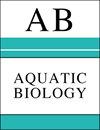Glycolytic capacities depend on developmental stage in the clownfish Amphiprion ocellaris
IF 0.8
4区 生物学
Q3 MARINE & FRESHWATER BIOLOGY
引用次数: 0
Abstract
Detailed knowledge about basic metabolism in the early life stages of fishes helps increase our understanding of energetically important life phases. However, little is known about metabolic capacities during ontogenetic development of anemone fishes before and after settlement. This study established activities of 3 key metabolic enzymes — citrate synthase (CS), pyruvate kinase (PK) and lactate dehydrogenase (LDH) — to establish oxidative and glycolytic capacities in eggs, larvae and juveniles of false clownfish Amphiprion ocellaris before and after hatch, and during ontogenetic metamorphosis from the pelagic to sedentary mode of life (settlement stage). Oxidative capacity significantly increased after hatching and remained constant throughout development. Compared to just-hatched larvae (1−2 d old), the glycolytic and fermentative capacities on the contrary were about 2.5and 2.1-fold higher in pre-settlement (7−8 d old) larvae, respectively, and decreased significantly in post-settlement (15 d old) juveniles. Thus, relative gly co lytic enzyme activity ratios verified that settlement-stage anemone fish larvae mostly rely on glycolytic capacities for the burst-swimming capabilities needed during settlement before entering into the benthic mode of life. Intraspecific variances in enzyme activities due to ontogenetic transition should be considered when using key metabolic enzymes as biomarkers for analysing larval physiological status.小丑鱼的糖酵解能力与发育阶段有关
关于鱼类生命早期基本代谢的详细知识有助于增加我们对能量重要生命阶段的理解。然而,人们对海葵鱼在定居前后的个体发育过程中的代谢能力知之甚少。本研究测定了三种关键代谢酶——柠檬酸合成酶(CS)、丙酮酸激酶(PK)和乳酸脱氢酶(LDH)的活性,以确定假小丑鱼卵、幼虫和幼鱼在孵化前后以及从深海到定居生活模式(定居阶段)的个体发育蜕变过程中的氧化和糖酵解能力。氧化能力在孵化后显著增加,并在整个发育过程中保持不变。与刚孵化的幼虫(1 ~ 2 d龄)相比,沉降前(7 ~ 8 d龄)的糖酵解能力和发酵能力分别提高了2.5倍和2.1倍,而沉降后(15 d龄)的糖酵解能力显著降低。因此,相对溶酶活性比验证了沉降期海葵鱼幼虫在进入底栖生活模式之前,主要依靠糖酵解能力来获得沉降期间所需的突发游泳能力。当使用关键代谢酶作为分析幼虫生理状态的生物标志物时,应考虑由于个体发生转变而导致的种内酶活性差异。
本文章由计算机程序翻译,如有差异,请以英文原文为准。
求助全文
约1分钟内获得全文
求助全文
来源期刊

Aquatic Biology
生物-海洋与淡水生物学
CiteScore
2.70
自引率
0.00%
发文量
7
审稿时长
3 months
期刊介绍:
AB publishes rigorously refereed and carefully selected Feature Articles, Research Articles, Reviews and Notes, as well as Comments/Reply Comments (for details see MEPS 228:1), Theme Sections, Opinion Pieces (previously called ''As I See It'') (for details consult the Guidelines for Authors) concerned with the biology, physiology, biochemistry and genetics (including the ’omics‘) of all aquatic organisms under laboratory and field conditions, and at all levels of organisation and investigation. Areas covered include:
-Biological aspects of biota: Evolution and speciation; life histories; biodiversity, biogeography and phylogeography; population genetics; biological connectedness between marine and freshwater biota; paleobiology of aquatic environments; invasive species.
-Biochemical and physiological aspects of aquatic life; synthesis and conversion of organic matter (mechanisms of auto- and heterotrophy, digestion, respiration, nutrition); thermo-, ion, osmo- and volume-regulation; stress and stress resistance; metabolism and energy budgets; non-genetic and genetic adaptation.
-Species interactions: Environment–organism and organism–organism interrelationships; predation: defenses (physical and chemical); symbioses.
-Molecular biology of aquatic life.
-Behavior: Orientation in space and time; migrations; feeding and reproductive behavior; agonistic behavior.
-Toxicology and water-quality effects on organisms; anthropogenic impacts on aquatic biota (e.g. pollution, fisheries); stream regulation and restoration.
-Theoretical biology: mathematical modelling of biological processes and species interactions.
-Methodology and equipment employed in aquatic biological research; underwater exploration and experimentation.
-Exploitation of aquatic biota: Fisheries; cultivation of aquatic organisms: use, management, protection and conservation of living aquatic resources.
-Reproduction and development in marine, brackish and freshwater organisms
 求助内容:
求助内容: 应助结果提醒方式:
应助结果提醒方式:


